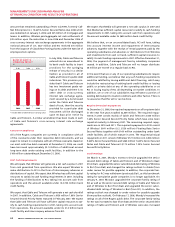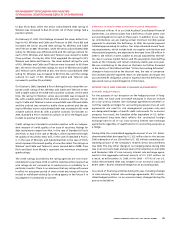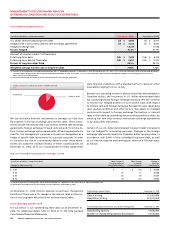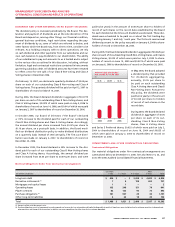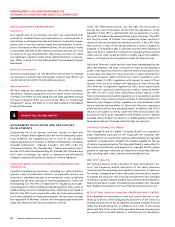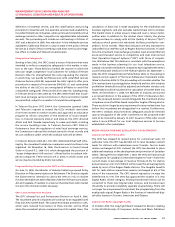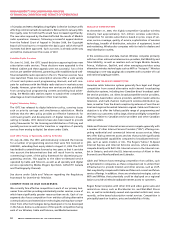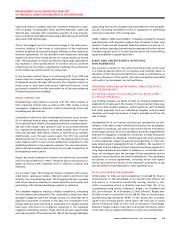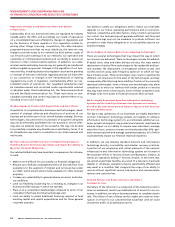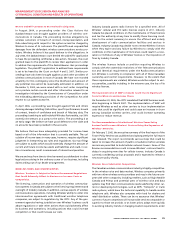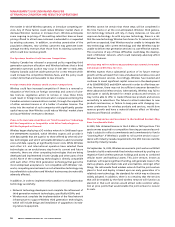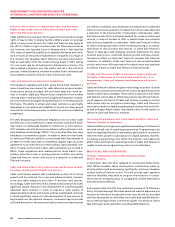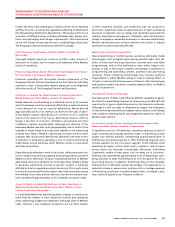Rogers 2006 Annual Report Download - page 56
Download and view the complete annual report
Please find page 56 of the 2006 Rogers annual report below. You can navigate through the pages in the report by either clicking on the pages listed below, or by using the keyword search tool below to find specific information within the annual report.
52 RO G ERS C OMM UNIC AT ION S IN C . 20 0 6 ANN UA L RE POR T
MANAGEMENT’S DISCUSSION AND ANALYSIS
OF FINANCIAL CONDITION AND RESULTS OF OPERATIONS
of Canada) and NRCC (Neighbouring Rights Collective Society) tariffs
affecting commercial radio broadcasters. Retroactive to January 2003,
the royalty rates for both tariffs would have increased significantly.
The new rates imposed by the Board affected the results of Media’s
radio operations. However, following a successful appeal decision
from the Federal Court of Appeal in October 2006, the Copyright
Board will now have to re-examine the basis upon which the tariff
increases had been approved. Such a process is already under way
and will be reviewed over the course of 2007.
Satellite Radio Ser vices
On June 16, 2005, the CRTC issued decisions approving three new
subscription radio services. These decisions were appealed to the
Federal Cabinet and these appeals were not successful. Two of the
services are satellite-delivered, partnering with established and well-
financed satellite radio operators in the U.S. These two services have
now launched. These new subscription services offer a wide variety
of music and spoken word programming channels, and will com-
pete for audiences with the Media radio stations in markets across
Canada. However, given that these new services are also prohibited
from carrying local programming content and selling local adver-
tising, the Media radio stations expect to sustain their competitive
advantage as local broadcasters in their local markets.
Digital Television Policy
The CRTC has released its digital television policy, covering issues
such as priority carriage and simultaneous substitution. Media
believes that the CRTC policy provides an effective framework for
continued growth and development of digital television broad-
casting in Canada. CRTC decisions have also been issued to provide
policy frameworks for the licencing and distribution of HD pay and
specialty services as well as the transition or migration of specialty
services from analog to digital. See above under Cable.
2007 CRTC Policy of Specialty and Pay T V Sector
On July 28, 2006, the CRTC administratively renewed the licences
for a number of programming services that were first licenced in
2000/2001, extending their expiry dates to August 31, 2009. The CRTC
has decided to extend these licences by two years so that it can take
into account the determinations that will result from its review,
commencing in 2007, of the policy framework for discretionary pro-
gramming services. This applies to the video-on-demand service
operated by Cable and Telecom, as well as all specialty and digital
services operated by Media (Rogers Sportsnet, G4TechTV Canada
and The Biography Channel).
See above under Cable and Telecom regarding the Regulatory
Framework for Over-the-Air Television.
COM P E T I T I O N I N O UR BUSI N E SS ES
We currently face effective competition in each of our primary busi-
nesses from entities providing substantially similar services, some of
which have significantly greater resources than we do. Each of our
segments also faces competition from entities utilizing alternative
communications and transmission technologies and may face compe-
tition from other technologies being developed or to be developed
in the future. Below is a discussion of the specific competition facing
each of our Wireless, Cable and Telecom, and Media businesses.
WIRELESS COMPETITION
At December 31, 2006, the highly-competitive Canadian wireless
industry had approximately 18.5 million wireless subscribers.
Competition for wireless subscribers is based on price, scope of ser-
vices, service coverage, quality of service, sophistication of wireless
technology, breadth of distribution, selection of equipment, brand
and marketing. Wireless also competes with its rivals for dealers and
retail distribution outlets.
In the wireless voice and data market, Wireless competes primarily
with two other national wireless service providers, Bell Mobility and
Telus Mobility, as well as resellers such as Virgin Mobile Canada,
Primus, Vidéotron, Eastlink, and other emerging providers using
alternative wireless technologies such as WiFi or “hotspots”. Wireless
messaging (or one-way paging) also competes with a number of local
and national paging providers.
CABLE AND TELECOM COMPETITION
Canadian cable television systems generally face legal and illegal
competition from several alternative multi-channel broadcasting
distribution systems, including two Canadian direct broadcast satel-
lite service providers, U.S. direct broadcast satellite service providers,
terrestrially-based video service providers, satellite master antenna
television, and multi-channel, multi-point wireless distribution sys-
tems, as well as from the direct reception by antenna of over-the-air
local and regional broadcast television signals. Cable and Telecom’s
objective is to offer the fullest possible range of programming and
services to our customers, with a large, diverse and highly-competitive
offering relative to Canadian service providers and other Canadian
cable providers.
Cable and Telecom’s Internet access services compete generally with
a number of other Internet Service Providers (“ISPs”) offering com-
peting residential and commercial Internet access services. Many
ISPs offer dial-up Internet access services that provide significantly
reduced bandwidth capabilities compared to broadband technolo-
gies, such as cable modem or DSL. The Rogers Yahoo! Hi-Speed
Internet Express and Internet Extreme services, where available,
compete directly with Bell’s DSL Internet service in the Internet mar-
ket in Ontario, and with the DSL Internet services of Aliant in New
Brunswick and Newfoundland and Labrador.
Cable and Telecom faces emerging competition from utilities, such
as hydroelectric companies, as these companies look to utilize their
infrastructure to provide Internet and other services, such as VoIP,
that may directly compete with Cable and Telecom’s current and future
service offerings. In addition, there are wireless technologies, such as
WiFi and WiMax, that potentially could be deployed on a regional
basis to provide wireless broadband Internet access to customers.
Rogers Retail competes with other DVD and video game sales and
rental store chains, such as Blockbuster Inc. and Wal-Mart Stores
Inc., as well as individually owned and operated outlets and, more
recently, online-based subscription rental services. Competition is
principally based on location, price and availability of titles.




